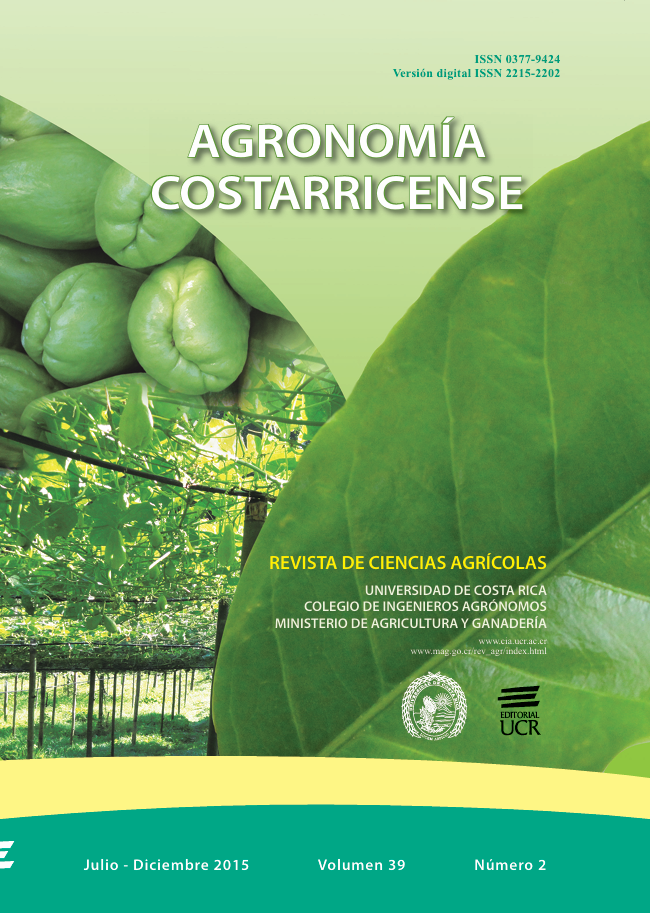Abstract
An analysis was made of the chain of processes and sub-processes in the production systems of vegetables for fresh consumption. Forty-four potential risk situations (PRS) were established, which were converted into questions and structured as a survey for growers. The variables and the formula that should be considered to quantify the risk were defined. The survey was conducted with a focus group of 70 produce growers in 13 different regions of the Central Valley in Costa Rica. A panel of experts was used to assess the risk level they felt the different survey-evaluated aspects could generate for end-product safety; the results identified the critical control points. From the survey’s statistical validation, the factor analysis identified a single factor explaining 10% of the variance. The value obtained for Cronbach’s Alpha was 0.9150, so the survey had a high level of reliability. The results on a 0-100 scale indicate that, for the evaluated population, all the produce-growing areas have high contamination risk levels. Llano Grande in Cartago Province has the lowest risk, with a value of 49, and the eastern Heredia Province area has the highest, with a value of 71. The results also confirmed high risk values in all evaluated crops, tomatoes showing the highest risk, with a value of 64; and celery having the lowest risk, with a value of 54.References
CENTRO DE COMERCIO INTERNACIONAL UNCTAD/ OMC. 2008. ISO 22000 Sistemas de gestión de la inocuidad de los alimentos. Lista de verificación para las PYME. Empresa Gráfica Mosca, Uruguay. 131 p.
ESPINOZA F. 2012. Procedimiento para evaluar el riesgo de la innovación en la gestión de mantenimiento industrial. Revista Chilena de Ingeniería 20(2):242- 254.
FALLAS J. 2002. Evaluación de la vulnerabilidad a la contaminación del agua subterránea en Costa Rica: Una aproximación utilizando el modelo DRASTIC y Sistemas de Información Geográfica. Escuela de Ciencias Ambientales, Universidad Nacional, Resúmenes XLVIII REUNIÓN ANUAL PCCMCA (Programa Centroamericano Cooperativo de Mejoramiento de Cultivos y Animales). Costa Rica, p. 139.
FAO. 2002. Risk assessments of salmonella in eggs and broiler chickens - interpretative summary. Serie Evaluación de Riesgos Microbiológicos N° 2. Consultado 25/10/13. Disponible en http://www.fao. org/docrep/005/y4393e/y4393e07.htm#bm07.4
FAO/OMS. 2008. Evaluación de la exposición a peligros microbiológicos en los alimentos: Directrices. Serie Evaluación de Riesgos Microbiológicos N° 7. 163 p.
FAO/OMS. 2009. Caracterización de Riesgos de Peligros Microbiológicos en los Alimentos: Directrices. Serie Evaluación de Riesgos Microbiológicos N° 17. 127 p.
KEENE W.E. 2006. Lessons from investigation of foodborne disease outbreaks. JAMA, 281, 19:1845-1847.
KOOPER G. Y INDA A. S.F. Estimación del impacto socio-económico de las enfermedades transmitidas por alimentos en Costa Rica. Consultado 20/10/13. Disponible en http://www.uci.ac.cr/descargas/ MIA/Ar ticulo%20CACIA%20impacto%20 ETA%20rev.pdf
MINISTERIO DE SALUD, COSTA RICA. 2011. Memoria Institucional. Consultado 5/12/13. Disponible en http://www.ministeriodesalud.go.cr/ sobre_ministerio/memorias/memoria2012/UMI_memoria_institucional_2011.pdf
LÓPEZ J.L. 1999. Calidad Alimentaria: riesgos y controles en la agroindustria. Ediciones Mundi-Prensa. Madrid, España. 316 p.
LUNA J., SIGNORINI M., DÍAZ R., ORDOÑEZ L. 2009. Evaluación de riesgos en alimentos. International Life Sciences Institute (ILSI), Impresión por Black Light Group. México. 45 p.
MEI S., JAN B., RICHARD N. 2013. Perceptual and Actual Risks and How We Comunicate Them, pp. 189-208. In: S. Mei, B. Jan and N. Richard (eds.). Managing Food Safety Risks in the Agri-Food Industies. CRC Press.
ORGANISMO INTERNACIONAL REGIONAL DE SANIDAD AGROPECUARIA (OIRSA). 2001. Manual para el control y aseguramiento de la calidad e inocuidad de frutas y hortalizas frescas. Coordinación Regional de Inocuidad de Alimentos. El Salvador. 63 p.
ORGANIZACIÓN MUNDIAL DE LA SALUD. (OMS). 2009. Caracterización de Riesgos de Peligros Microbiológicos en los Alimentos. Consultado 29/4/13. Disponible en ftp://ftp.fao.org/ag/agn/ jemra/17s.pdf
TRUJILLO C.M., MARRERO Y. 2007. La estimación de pérdidas agrícolas en condiciones de riesgo. Congreso Internacional de las Ciencias Agropecuarias. Memoria. La Habana, Cuba, p. 38.


